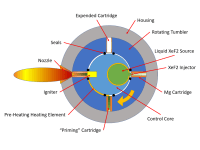The Tumble Thruster Module (TTM) concept utilizes the high energy reaction of igniting a solid cartridge of Magnesium (Mg) together with injected Xenon(II) Floride (XeF2). The resulting Mg/XeF2 (also known as MAX) propellant combination stems from a 2008 paper on spectra research of the high energy density material by Ernst-Christian Koch [1]. The TTM combines the solid rocket motor with a controlled additive in a system also known as a hybrid rocket. This variant of the hybrid rocket is non-throttlable meaning once ignited the reaction continues until all the reactive propellant combination is burnt. What is controllable is the total amount of additive propellant introduced to the system prior to ignition and as a result the amount of energy each thruster firing can apply towards thrust generation.
The Mg cartridges used as the primary propellant are cast in a mold that places cavities of varying sizes throughout the solid. These cavities enable the injection of XeF2 during the priming process. Multiple cartridges are inserted and housed in a heated tumbler which rotates within the thruster module. As the tumbler rotates within the module, cartridges are held at specified points where they are primed, pre-heated, and ignited. A new cartridge starts empty of XeF2 and moves to an injector where it is primed with XeF2 in either its liquid or gaseous state. Thruster performance can be modified by varying the density of XeF2 injected into the Mg cartridge via temperature or pressure. After injection, the now primed MAX cartridge rotates through a supporting preheating element to bring the temperature of the propellant closer to its ignition point. When the propellant is ready for ignition, the tumbler will rapidly move the cartridge into position aligned with the thruster nozzle while a continuous arc ignition source simultaneously ignites the heated propellant. The resulting reaction and generated product is directed from the cartridge housing and through the nozzle for thrust generation.
TTMs can be designed to be refilled after expending all the cartridges but at the cost of added mass to the system. The modules may be more useful as correction or energy adding thrusters for impacters and autonomous landers. Use on cubesats may also be a viable option depending on the mechanical profile designed. The TTM concept allows the mechanical design of the system to be scaled dependent on the performance requirements of the spacecraft and energy availability for heating the propellants. The nature of the propellant reaction and ignition is not conducive to systems that need instant thrust availability like orientation thrusters provide but more towards specific delta-v injections similar to what orbit injection thrusters provide. The TTM however may provide higher energy reactions than the a standard pulse thruster of similar size with potentially more efficient use of mass thanks to the high energy density propellant.
Image 1: Tumble Thruster Module (TTM) - Vertical Bi-Cartridge Profile
Image 2: TTM Concept Diagram
Image 3: TTM Vertical Bi-Cartridge Profile Cross-section
[1] "Magnesium Xenon(II) Fluoride (MAX) a New High Energy Density," Ernst-Christian Koch
Like this entry?
-
About the Entrant
- Name:Carlos Rodriguez
- Type of entry:individual
- Patent status:none








